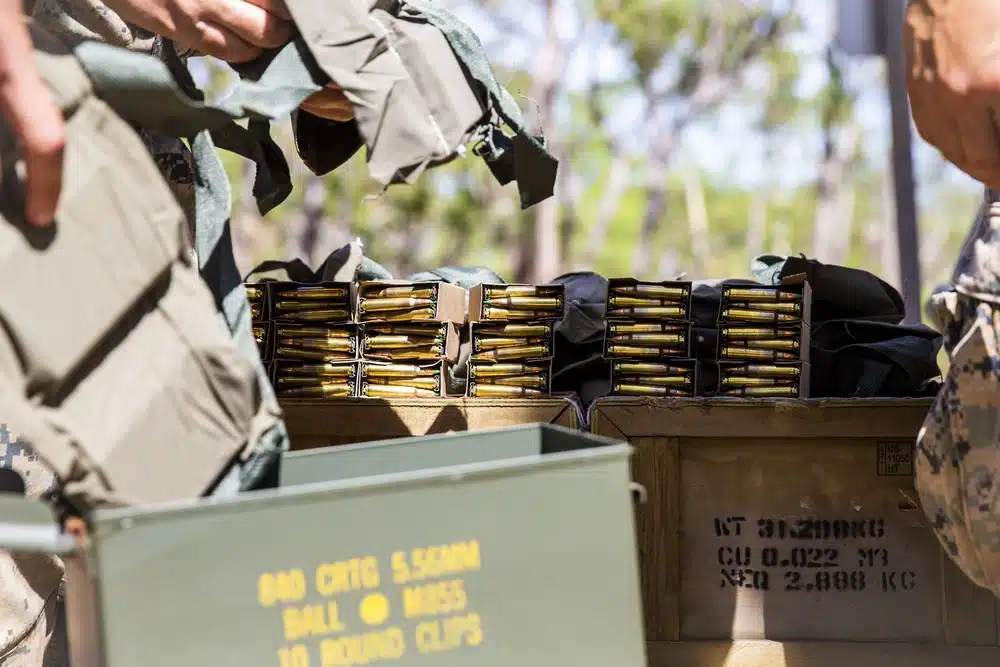
When selecting the proper ammunition for an AR-15 or similar rifles, the weight of the bullet can significantly influence performance.
The .223 Remington and its military counterpart, the 5.56x45mm NATO, are among the most versatile and widely used cartridges. They offer a range of bullet weights to suit different needs and preferences.
This blog post delves deep into the performance differences between the two most popular weights—55-grain and 62-grain—highlighting how each performs in terms of velocity, energy, and effectiveness in various shooting scenarios. By understanding these differences, shooters can make more informed choices about the ammunition they use for target shooting, competition, or hunting.
Performance Comparison: 55 Grain vs. 62 Grain Ammunition
When examining the differences between 55-grain and 62-grain 5.56 ammunition, it’s essential to understand how these variations affect performance, particularly in terms of ballistics, penetration, and suitability for different firearms. Both types of ammunition are commonly used in rifles chambered for 5.56 NATO, such as the AR-15 platform, but they serve different purposes and exhibit unique characteristics in various shooting scenarios.
Ballistic Performance
The 55-grain 5.56 ammo is generally lighter and faster than its 62-grain counterpart. It typically exits the barrel with higher velocities, often exceeding 3,000 feet per second. This high velocity contributes to a flatter trajectory over short to medium distances, making it a preferred choice for target shooting and varmint hunting, where rapid expansion and fragmentation on impact are desirable.
In contrast, 62-grain 5.56 ammo, often loaded with a slightly heavier projectile, travels at a lower velocity, usually around 2,900 feet per second. The additional weight provides greater stability in flight, especially under windy conditions, making it more effective at longer ranges. This characteristic mainly benefits military and tactical applications, where engagement distances vary greatly.

Velocity Comparison (in feet per second)

Energy Comparison (in foot-pounds)

Penetration and Impact
Their construction and weight significantly influence the penetration characteristics of 55-grain versus 62-grain ammo. The lighter 55-grain bullets tend to fragment more readily upon impact, especially at higher velocities. This fragmentation can result in extensive tissue damage in hunting scenarios but may also lead to over-penetration issues in home defense situations.
The 62-grain rounds often feature a steel penetrator tip, particularly in the M855 military-style ammo. This design enhances penetration capabilities, allowing the bullet to maintain its path through harder barriers like wood or thin metal. It’s a crucial feature for combat scenarios but can be a double-edged sword in civilian use, as the increased penetration might pose a higher risk of collateral damage.
Suitability for Firearms
Another important consideration is the twist rate of the rifle’s barrel, which affects the stability and accuracy of the bullet. Rifles with a 1:12 twist rate are typically better suited for lighter bullets such as the 55-grain, whereas a 1:7 or 1:8 twist rate favors the heavier 62-grain bullets. Using ammunition compatible with your rifle’s barrel twist rate is essential for achieving optimal accuracy and performance.
Many manufacturers, such as Faxon Firearms, manufacture barrels and rifles with the jack-of-all-trades 1:8 twist rate. This gives you the best possible performance across the most common bullet weights for 5.56.
Practical Applications
Choosing between 55-grain and 62-grain 5.56 ammo often depends on the specific needs and scenarios the shooter anticipates. For general target shooting and hunting smaller game, 55-grain ammo offers the advantages of a flat trajectory and rapid expansion. On the other hand, for tactical training, self-defense, or hunting in environments with thicker cover or longer ranges, 62-grain ammo with its enhanced penetration and stability in flight might be the better choice.
In conclusion, 55-grain and 62-grain 5.56 ammunition have distinct advantages and disadvantages. Selecting the right one depends on understanding these differences and how they align with your shooting goals and environmental conditions. Matching the ammunition to the specific task will enhance performance and effectiveness, whether for competitive shooting, hunting, or tactical purposes.







Leave a Reply
Your email address will not be published. Required fields are marked *